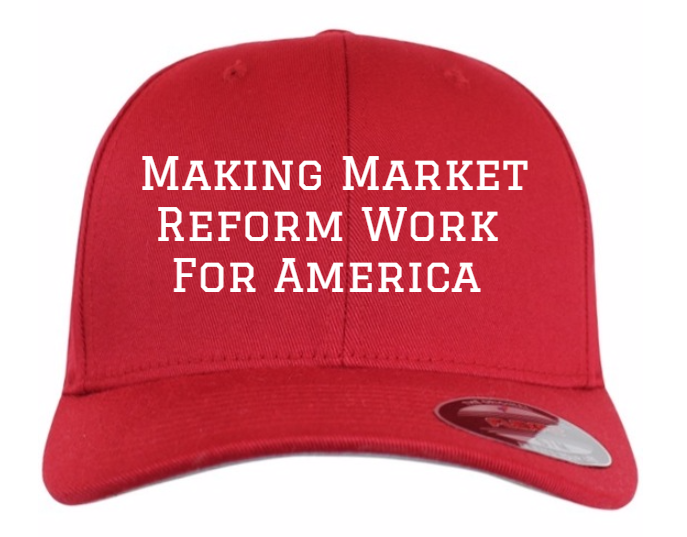I attended SEFCON 7 yesterday to see what is going on in the world of Swap Execution Facilities. I had been thinking SEF’s were business as usual by now, so I went to see if anything cooking in the oven, or might be cooking after the Trump administration starts up.
Session 1
Chairman Massad gave his 3rd SEFCON keynote, filled largely with accomplishments for his tenure as chairman. Things like Uncleared Margin rules, cleaning up swaps reporting, and clearing house stress tests. There is even a link to the full 15-page document of accomplishments here.
 The Chairman suggested that the new administration not dismantle the framework on swaps that has been built, but instead refine it. This seemed a common theme.
The Chairman suggested that the new administration not dismantle the framework on swaps that has been built, but instead refine it. This seemed a common theme.
Session 2
Session 2 was House Representative Bill Huizenga being interviewed. The Republican Congressman is from the typically blue (Democratic) state of Michigan, which of course voted red this most recent election. Very telling that this happened despite seemingly very good economic health of his district, with 2% unemployment. He’s on the House Financial Services Committee. His views on swaps, or whether swaps was even discussed, frankly I forget!
Session 3
Session 3 was Commissioner Giancarlo. Come Friday Jan 20, when Massad steps down, Giancarlo will be the acting Chairman, and from what I could glean, a decent certainty to be nominated to upgrade into full-Chairman title. The key takeaway being that he “Fully Supports Title 7 reforms”. While I had that verbatim in my notes, it seems the official text does not have the “Fully” part.
Of course he is critical of many of the SEF rules, such as the MAT process and execution methods, which he eloquently wrote about in his white paper. So we can expect there to be some attempted tinkering of those, but title 7’s clearing and swap data reporting aspects should be largely kept whole and simply improved upon where possible. Special mention was given to the SDR reporting, where he cited continued problems with swap data, particularly when looking at it holistically across the globe.

He’s also a technology fan, notably around distributed ledger technology, and would like to have a team at the Commission dedicated to the analysis of FinTech. He had a nice quote about the CFTC being an “analog regulator in a digital marketplace”. Probably in good company at least.
His mantra is “Making Market Reform Work For America”. Remind you of anything? I think he needs his own hat.
Session 4
Session 4 was a panel with Vince McGonagle of CFTC DMO, Keith Bailey of Barclays, Bill Shields of GFI, and Mark Wetjen of DTCC.
To define the problem there was the usual whining about how regulation hinders business. Examples such as a broker having to set up STP processes, position limits, and an inactive order book. Further, for banks to have to connect to all the SEFs as just some examples.
Vince hinted that its likely that the MAT rules, notably the process by which products become MAT’d, might be up for change (again).
Lots of talk about equivalence, now that the EU has some more firm definitions of OTFs, MTFs, etc, etc. Its such a complicated issue, it usually makes my eyes gloss over, and today was no different.
In the Q&A it became clear we might not expect a whole lot in year 1 of the new regime, given that we’ll start with only 2 commissioners. But everyone agreed they’d still be miles ahead of any such SEC swap rulemaking.
Lunch Break
Over lunchtime, Larry Tabb walked us through some survey results they commissioned, surrounding the new presidency. Things like 70% of respondents believing America should build a wall, and only 65% feeling America would build a wall. I recall very few felt Mexico should or would pay for it. Further, roughly 17% felt there should be some immigration bans. I wish I could find Larry’s presentation online somewhere.
Session 5
Session 5 was the “buyside” panel. Stephen Berger from Citadel, Kristin Boggiano from Women in Derivatives, Darcy Bradbury from DE Shaw, and Michael O’Brien from Eaton Vance.
Michael kicked off the discussion by stating that from their perspective, there really had been no innovation in swap trading over the past 6 years. They used to call up 1 or 2 dealers for a price, and now they ping 1, 2 or 3 dealers for a price on a SEF. The order books are still off limits to particular buyside, given issues like how to do average pricing and the name giveup.
Stephen was quick to point out the BOE paper that discusses $10mm / day of savings to swaps participants from the firmer pricing and tighter spreads. And Darcy added that the new rules have indeed made trading swaps operationally easier.
The Uncleared Margin Rules (UMR) got a mention here as well. Darcy cited that these were too punitive for products that are un-clearable. I hadn’t considered the buyside perspective before – but of course most of them already post margin to a dealer on some basis. Clearly that basis is cheaper than what will hit them come Sep 2018 or 2019 when UMR goes into effect.
The March 1 variation margin component also got mentioned. Seems there is hope that this gets pushed out 6 months like HK, Singapore and Australia has done. Even if its retroactively effective, they claim to need more time, given that each fund needs to be re-papered with each counterparty.
Lastly, this is the second time I have heard Stephen say that all this talk of liquidity fragmentation is “illusory”. His line of reasoning makes perfect sense. I think we need to get Stephen on a panel with Giancarlo and get to the bottom of this one.
Session 6
Session 6 was a Panel chaired by Kevin McPartland. He had Scott Fitzpatrick of Tradition, Scott O’Malia of ISDA, Amir Zaidi of CFTC and Kayam Rajaram of DeutscheBank.
I thought the first question was a bit of a layup. I forget the actual question, but the question the panel answered was “does the market need large dealers?” And when you ask this to an Interdealer broker, a dealer, and a dealer association, you can pretty much anticipate the answers.
The spirit of the question was surely intended to drill into how the CFTC engineered the rules to be futures-like to allow for liquidity to come from a larger audience, such as Chicago Prop Trading firms. But these firms have been unable to make the leap into this market. But I’ll save my rant there. It does make me wonder though – the dealers have ISDA, what do the Chicago Prop firms have?
If anything, I have to side with Giancarlo’s (dealer based) view here. Liquidity is what it is in the swaps market. It just so happens that previous commissioners might have sold the concept of “all to all” futures-style trading without having the remit to do that.
Summary
I walked away with a clearer picture of how the (presumed) Giancarlo CFTC would support the existing title 7 in large part but with some tweaks to SEF execution mandates to be more like the EU (and presumably global best practices). He gets the tail end of the reform, so he’ll generally get the hard part of it all – trying to make it work in conjunction with global reforms without jeopardizing the industry in America.
Should be interesting times. We’ll of course stay on top of it.

Man, Tod, what a great report! Sounds like the Trump Revolution will herald in a new era of tinkering around the edges.
Very interesting feedback. Thanks Tod.